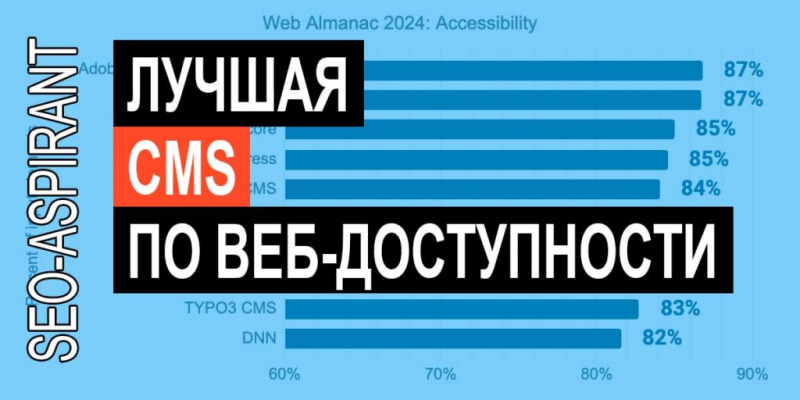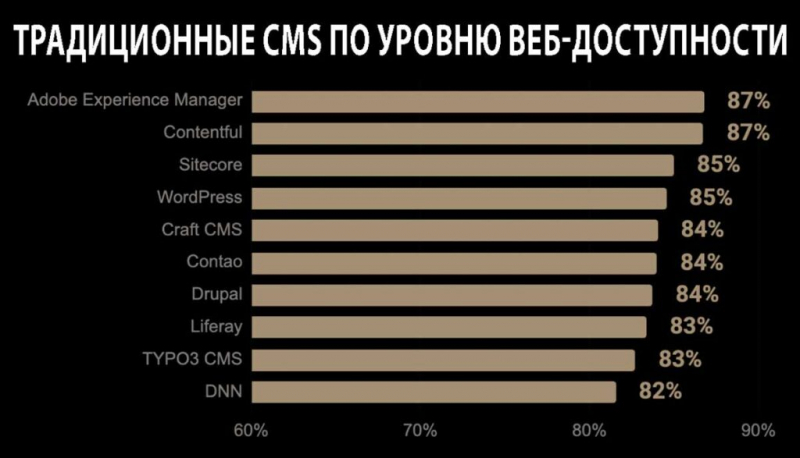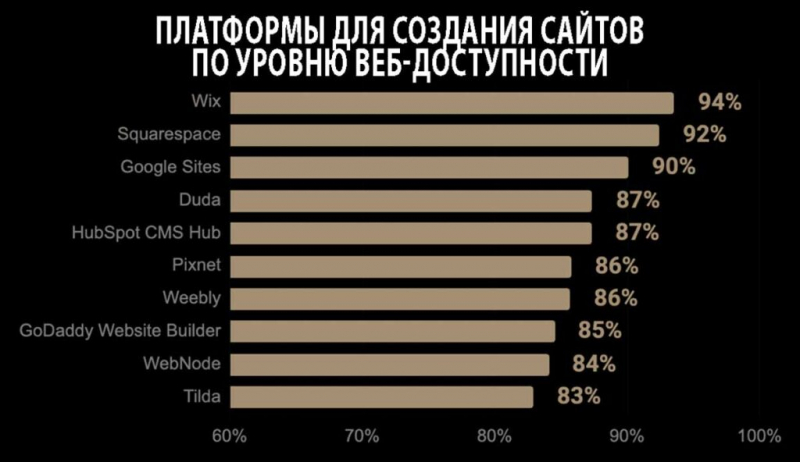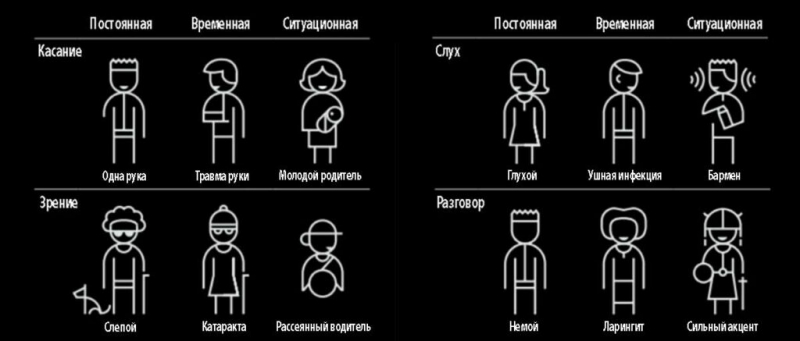Twenty CMS and website creation platforms were ranked according to the degree of web accessibility. WordPress got good results, but the winner may surprise you.
HTTP Archive has published a report on the state of web accessibility of websites on the Internet, based on estimates obtained using Lighthouse Accessibility Audit, a function of Google’s Lighthouse website audit tool that evaluates website performance and SEO indicators.
The report compares traditional content management systems and website creation platforms, with WordPress receiving unexpectedly high ratings.
Lighthouse is a feature available through Chrome DevTools, built into every Chrome-based browser, as well as as one of the types of auditing in a separate PageSpeed Insights tool.

Recommendation of the month: Telega.in — native integration platform in Telegram channels. Manually verified channels and bots. We help you find your target audience on Telegram and launch effective integrations.
- HTTP Archive
- The best CMS in terms of web accessibility
- Traditional CMS
- CMS Web accessibility rating
- Web accessibility and platforms for creating websites
- Ranking of platforms for creating websites by web accessibility
- Wix is ahead of everyone
- Web accessibility of sites
HTTP Archive
The research was conducted by the HTTP Archive, an open source project run by a community of enthusiasts that tracks data on how websites are created and operated on the Internet. They create a customized report on the performance of various content management platforms, which is updated monthly.
The Website accessibility report was compiled based on data collected during The WebAIM Million study, which is based on data on the first million main pages of websites on the Internet.
WebAIM Million uses data from the Tranco list, which itself is based on six different sources, and serves as a tool to create a list of 1 million sites that is designed to be resistant to manipulation.
Here is an explanatory quote from the website Tranco List:
“Researchers in the field of webRatings of popular websites are often used for security or Internet measurements. However, in our article, we showed that these ratings are inconsistent with which domains are the most popular, can change significantly on a daily basis, and can be manipulated (by intruders).
Since the research community still needs regularly updated lists of popular domains, we offer a Tranco rating that corrects the shortcomings of existing lists. We also emphasize the reproducibility of these ratings and the studies using them by providing permalinks.
We currently use listings from five vendors: Cisco Umbrella (available for free), Majestic (available under CC BY 3.0 license), Farsight (only for the default list), Chrome User Experience Report (CrUX) (available under CC BY-SA 4.0 license) and Cloudflare Radar (available under license CC BY-NC 4.0). Tranco is not affiliated with any of these suppliers.”
The best CMS in terms of web accessibility
HTTP Archive conducted a study to identify the most effective platforms and highlight the disadvantages of each of them.
Traditional CMS
Adobe Experience Manager and Contentful took the first place among traditional content management systems in terms of accessibility, gaining 87%, followed by Sitecore and WordPress, which took second place.
An interesting fact in the CMS ranking is that, with the exception of WordPress, three of the four CMS are closed source: Adobe Experience Manager (AEM), Contentful and Sitecore.
CMS web accessibility rating
- Adobe Experience Manager (87%)
- Contentful (87%)
- Sitecore (85%)
- WordPress (85%)
- Craft CMS (84%)
- Contao (84%)
- Drupal (84%)
- Liferay (83%)
- TYPO3 CMS (83%)
- DNN (82%)

Another comment about CMS web accessibility from HTTP Archive:
“When most people think about CMS, they think about those that you can download and install yourself. These are mostly open source tools, but not only that.
Adobe Experience Manager (AEM), Contentful, and Sitecore were the most web-accessible in this top 10 list. This can be explained by the fact that closed-source software, such as AEM, is more often used by large corporations that have more resources to address accessibility issues.
In addition, open source software provides website owners with more freedom, which in some cases can lead to a deterioration in web accessibility.”
Web accessibility and platforms for creating websites
A separate comparison is carried out for specialized platforms for creating websites: tools such as Wix, Duda and Squarespace are compared.
Web accessibility ratings for these platforms were higher than for traditional CMS, reflecting the fact that private platforms have better control over specific variables, unlike open source CMS, which offer users a freer choice of actions.
Rating of platforms for creating websites by web accessibility
- Wix (94%)
- Squarespace (92%)
- Google Sites (90%)
- Duda (87%)
- Hubspot CMS Hub (87%)
- Pixnet (86%)
- Weebly (86%)
- GoDaddy Website Builder (85%)
- Webnode (84%)
- Tilda (83%)

Wix is ahead of everyone
It is noteworthy that sites created on Wix received higher web accessibility scores than all other sites created on any other CMS or website creation platform.
The full list, in descending order:
- Wix – 94%
- Squarespace – 92%
- Google Sites – 90%
- Adobe Experience Manager – 87%
- Contentful – 87%
- Duda – 87%
- Hubspot CMS Hub – 87%
- Pixnet – 86%
- Sitecore – 85%
- WordPress – 85%
- GoDaddy Website Builder – 85%
- Weebly – 86%
- Craft CMS – 84%
- Contao – 84%
- Drupal – 84%
- Webnode – 84%
- Liferay – 83%
- TYPO3 CMS – 83%
- Tilda – 83%
- DNN – 82%
Web accessibility of sites
Web accessibility (web accessibility or eaccessiblity) is an inclusive practice of ensuring that there are no barriers preventing people with physical disabilities, situational limitations, as well as socio-economic limitations in bandwidth and speed from interacting with websites on the World Wide Web. When websites are properly designed, developed, and edited, more users have equal access to information and functionality.
SEO specialists always try to use the best practices and tools in order to rank better in organic search. Many people did not attach importance, for example, to performance until it became a ranking factor, although site performance initially has a positive effect on sales and advertising, and may also indirectly affect ranking.
Web accessibility also has indirect benefits for improving SEO metrics. For example, about 0.5% of women and 8% of men are colorblind. Why would those who actively care about organic traffic and ranking (you and me) alienate, upset, and exclude approximately 4.5% of site visitors?

Wix and Squarespace prioritize web accessibility. Everyone else should do it too, because it’s both ethical and reasonable from a business point of view.
You can read the full HTTP Archive report here: almanac.httparchive.org.
